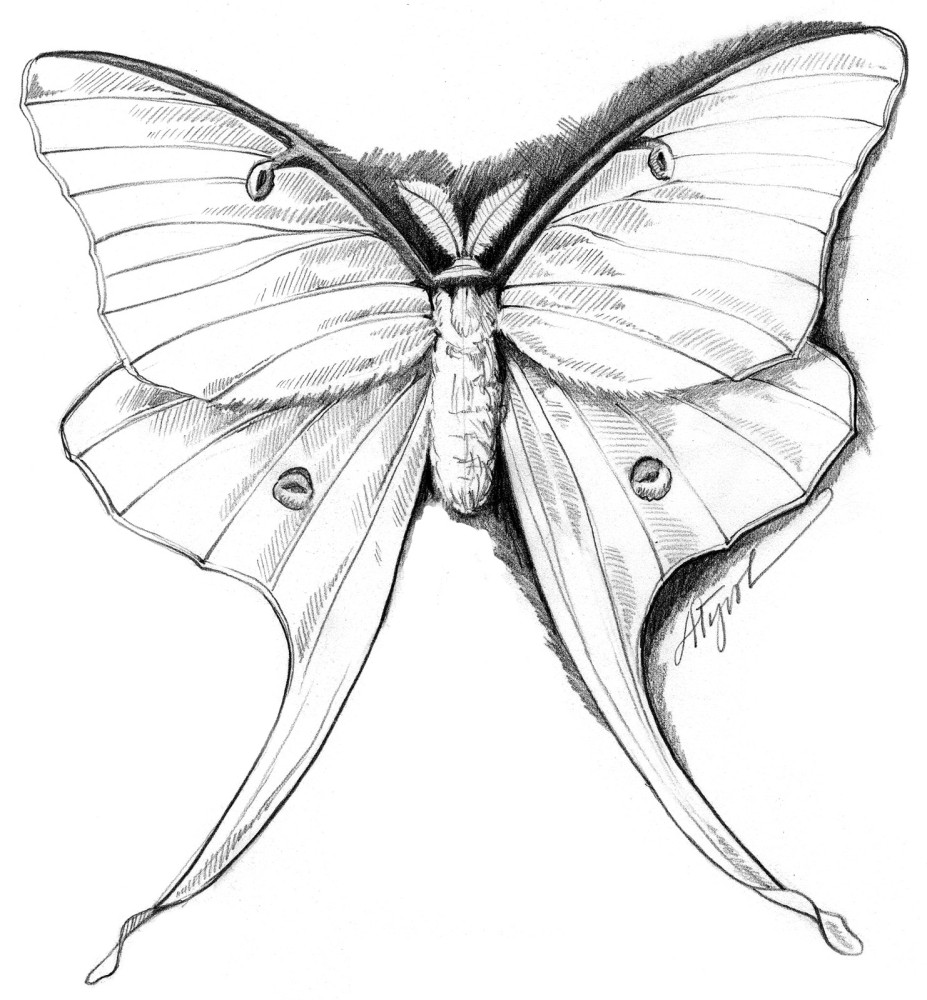
On early summer nights I sometimes see large, pale green moths with long, twisted tails fluttering near our porch light. Later, I often find them dead on the ground. These beautiful moths are luna moths, named for the Roman goddess of the moon. Each of their four wings has a transparent, moon-shaped eyespot.
The luna moth (Actias luna) is one of the largest species of moths in North America, with a wingspan of three to four inches. It inhabits deciduous forests, where its green wings blend in among the leaves.
The moths I’ve seen near my porch light were likely getting ready to mate. The female luna moth releases a pheromone which males can detect from a distance with their comb-like antennae. Mating takes place after midnight, and the female begins laying eggs the following evening and continues for several nights. Adult luna moths have no mouthparts and do not feed, surviving on stored fat from the larval stage. Their sole purpose is to reproduce, and they die after about a week. Hence the dead green moths I’ve found around my house.
Eggs are laid on the leaves of paper birch, hickories, and other trees. The caterpillars hatch after about a week and begin a month-long eating binge that increases their weight a thousand-fold. To accommodate this growth, the larvae shed their skin four times. The full-grown luna moth caterpillar is about three inches long and bright green with a yellow side stripe. Rows of red tubercles with protruding hairs decorate each side. Despite their leaf-munching, the caterpillars do not cause serious damage to trees since luna moths are not abundant. According to biologist Kent McFarland of the Vermont Center for Ecostudies, moth larvae are a key resource for songbirds raising their young. Some predators may be deterred, however, by the luna caterpillar’s defense. When it senses a threat, the caterpillar rears up, makes a clicking sound with its mandibles, and regurgitates a foul-tasting liquid.
When it is full grown, the caterpillar spins a cocoon around itself, using silk and the leaves of the host tree. In autumn, the brown, papery cocoon drops to the ground when the leaves fall, and overwinters in the leaf litter. As temperatures warm and days lengthen in late spring and early summer, the adult luna moth emerges from the cocoon, expands and dries its wings, beginning the ancient cycle again.
Since they do not feed, adult luna moths do not pollinate forest trees like other moth species. But the adults are food for bats, owls, and the nocturnal whippoorwill. The luna moth’s twisted tail is designed to interfere with echolocation by hunting bats. Experiments in wind tunnels have shown that lunas with tails are less likely to be caught by bats than lunas whose tails have been removed.
The luna moth is considered common in Vermont, said McFarland, though good population data for moths is lacking. He encourages citizens to post sightings of lunas and other moths to i-Naturalist. A good way to observe and photograph moths is to hang a white sheet on a building, clothesline, or between two trees and shine a light on it. Some moths are particularly attracted to ultraviolet light or “black light.” Backyard moth-watching has resulted in the discovery of hundreds of new locations for certain moth species. Make sure you turn off the light when you’re finished observing, as nighttime lighting can confuse moths and deter them from mating. Moths can also be attracted to a mixture of sugar and overripe fruit smeared on tree trunks.
Populations of lunas and many other moths of the saturniid family, also called the giant silk moths, have declined in southern New England. Threats to these large, colorful moths include habitat loss, pesticides, artificial lighting, and especially, a European tachinid fly (Compsilura concinnata). This fly species was first introduced in 1906 to control gypsy moths, but in addition to the luna, it parasitizes other silk moth larvae, including the promethea, polyphemus, cecropia, and rosy maple moth.
The next time I see luna moths on my porch, I’ll turn off the light and give them back the night. I’ll dream of these pale green goddess moths mating beneath the light of the moon while the human world sleeps.


Discussion *